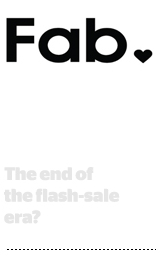 Akin to an infant reaching its “Terrible Two’s,” designer flash sale site Fab.com has changed a lot in the period following its second year.
Akin to an infant reaching its “Terrible Two’s,” designer flash sale site Fab.com has changed a lot in the period following its second year.
The good? The ecommerce company, founded in 2011, inked $150 million in Series-D financing from Atomico, Andreessen Horowitz, Tencent, ITOCHU and others, bringing its running tally to $310 million in less than three years’ time. The new round of financing will go toward executing long-term strategy to operate the “world’s design store,” Fab.com Founder & CEO Jason Goldberg wrote by way of his blog platform, Betashop.
The painful? Goldberg announced yesterday plans to cut 100-plus positions in the company’s Berlin office in a push to “centralize much of our operations at our New York headquarters” while continuing to execute on its strategy to become a “comprehensive online lifestyle shop.” Fab.com’s German office will remain intact to provide customer support, shipping and logistics, etc. for the European market, while 30 Berlin employees will be moved to New York.
Additionally, Fab.com will reinvest in engineering staff and hire “significantly” in sourcing and planning as it consolidates merchandising, marketing and operations into a single unit in New York, Goldberg wrote. Citing an evolution of its business model and a pivot away from flash sales to a more scalable, inventory-planning commerce model, Fab.com’s new trajectory hints at the growing viability of a highly personalized, curated commerce experience where inventory isn’t there one day and gone the next.
Platforms like Fab.com, Gilt Groupe, HauteLook and Rue La La, which were somewhat popularized by the fanfare associated with the flash sale phenomena, could face unforeseen competition from the traditional retail set.
“What I see, increasingly, in the RFPs that retailers are putting out [in their selection of commerce platform technologies] are requirements for flash sales, marketplaces, private label sites or [the ability to sell] partner products directly through their online channel,” said Peter Sheldon, a principal analyst for e-business and channel strategy, at Forrester Research, as more brick and mortars adapt to keep up with Amazon.
With increased interest in private portals or marketplaces where exclusive offers and deals are controlled or authenticated through membership or loyalty components, there could come additional paid media opportunities. But for the online players like Fab that are pivoting away from a pure flash-sale model and that have loosened their grip on membership, it’s all about experimenting and building on what works; social media, for Fab, has been where most of the referral traffic to its site stems from.
Earlier this spring, Goldberg called “Facebook our most effective marketing channel,” with about 30% percent of daily traffic to Fab.com coming through the social network. Every action published through Facebook Connect generates four clicks back to Fab.com and purchasers targeted through Custom Audiences have been 10 times more likely to buy.
“Search engine marketing was more about a single intent and converting that intent to a purchase right then…and [with Facebook] we saw an opportunity to get people to be interested in this type of product, lifestyle,” Goldberg said in a testimonial for Facebook. Last fall, Fab.com launched its first national TV ad campaign and was estimated to spend $25 million on Facebook advertising in 2012, according to Forbes.












